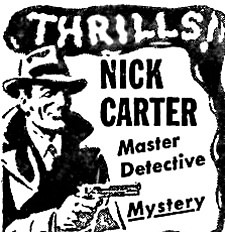
 Nick Carter, Master Detective (1943-1955) aired “The Case of the Sick Statue” on August 12, 1945. This is the 17th Nick Carter episode we’ve run since 2009. Carter’s history is long, covers numerous media, and is one of the more fascinating we’ve come upon. To crib from one of our earlier entries for new listeners, and slightly tweaked with new material, Nick Carter on radio ran a respectable twelve years, from 1943-1955, but the famous detective’s history begins much earlier. During the post-Civil War era known as Reconstruction, a short story featuring Carter appeared in an obscure fiction paper (The New York Weekly) in 1886 (predating the first Sherlock Holmes story by two years). The publisher was none other than Street & Smith, a fledgling, struggling publishing firm which would later become the most dominant pulp magazine publisher in the world. Among its later titles would be Astounding Science Fiction (now Analog), the only magazine from Street & Smith to survive the pulp magazine crash of the 1950s.
Nick Carter, Master Detective (1943-1955) aired “The Case of the Sick Statue” on August 12, 1945. This is the 17th Nick Carter episode we’ve run since 2009. Carter’s history is long, covers numerous media, and is one of the more fascinating we’ve come upon. To crib from one of our earlier entries for new listeners, and slightly tweaked with new material, Nick Carter on radio ran a respectable twelve years, from 1943-1955, but the famous detective’s history begins much earlier. During the post-Civil War era known as Reconstruction, a short story featuring Carter appeared in an obscure fiction paper (The New York Weekly) in 1886 (predating the first Sherlock Holmes story by two years). The publisher was none other than Street & Smith, a fledgling, struggling publishing firm which would later become the most dominant pulp magazine publisher in the world. Among its later titles would be Astounding Science Fiction (now Analog), the only magazine from Street & Smith to survive the pulp magazine crash of the 1950s.
(Photo top right: Alfred Bester [author of this episode] at the 1976 World SF Convention, Kansas City, MO.)
Award-winning radio historian Elizabeth McLeod notes that, “Within a decade, an ongoing series of Nick Carter novels vaulted [Street & Smith] to the front ranks of dime-novel publishers, and made Nick himself a national institution. Nick’s own magazine, The New Nick Carter Weekly, would carry the detective into the twentieth-century.” By 1915, however, the then titled Nick Carter Weekly became Street and Smith’s Detective Story Magazine, a true pulp magazine and S&S’s initial entry into this new format. Again, from Elizabeth McLeod: “Detective Story Weekly soon became Street and Smith’s flagship publication. With the rise of radio in the 1920s, it became the firm’s entree into the broadcast medium. The Street and Smith Detective Story Hour became a favorite of listeners at decade’s end, with elaborate tales of murder and crime hosted by a mysterious narrator introduced only as “The Shadow.” While Nick Carter himself did not appear on the program, his spirit was very much in evidence in the various detective characters that populated the stories.” Of course, we all know what happened next. The mysterious voice only introducing the S&S Detective Story Hour became so popular that S&S launched The Shadow magazine in 1931, and shortly thereafter S&S added Doc Savage to its pulp adventure line. Amidst all of this activity Nick Carter was even given his own magazine (again) in 1933, proving the character’s resiliency and staying power–he was now 47 years old.
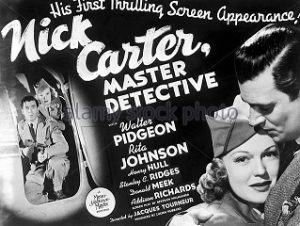
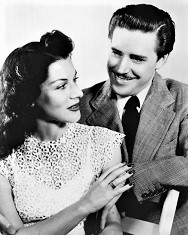 Nick Carter Magazine ran for 40 issues, from March 1933 to June 1936, the final six issues slightly retitled as Nick Carter Detective Magazine. While the magazine had folded, its long-running character still lived, for in 1939 Hollywood picked up the movie rights and produced three “B” Carter films starring noted actor Walter Pidgeon* (who later would star in the classic 1956 SF film Forbidden Planet). A mere three years later, Nick Carter would rise from the dead yet again in his own radio series, Nick Carter, Master Detective. The show’s producer and often the writer, Sherman “Jock” MacGregor, would enlist some of the best writers in the business to script Carter’s episodes, including Robert Arthur and David Kogan of Mysterious Traveler fame, the creator of The Shadow, Walter Gibson, and none other than legendary SF author Alfred Bester (one of which Bester-written episodes, “Chemical Chickens,” we ran in March of 2014 here). Lon Clark played Nick Carter throughout its 12-year run, ably supported by first Helen Choate until mid-1945 and then Charlotte Manson (photo above right with Lon Clark) as Nick’s intelligent, perky secretary Patsy Bowen. Other mainstay characters included Police Sergeant Matty Mathieson, young newspaper reporter Scubby Wilson, and scruffy old veteran of the crime game Waldo McGlynn.
Nick Carter Magazine ran for 40 issues, from March 1933 to June 1936, the final six issues slightly retitled as Nick Carter Detective Magazine. While the magazine had folded, its long-running character still lived, for in 1939 Hollywood picked up the movie rights and produced three “B” Carter films starring noted actor Walter Pidgeon* (who later would star in the classic 1956 SF film Forbidden Planet). A mere three years later, Nick Carter would rise from the dead yet again in his own radio series, Nick Carter, Master Detective. The show’s producer and often the writer, Sherman “Jock” MacGregor, would enlist some of the best writers in the business to script Carter’s episodes, including Robert Arthur and David Kogan of Mysterious Traveler fame, the creator of The Shadow, Walter Gibson, and none other than legendary SF author Alfred Bester (one of which Bester-written episodes, “Chemical Chickens,” we ran in March of 2014 here). Lon Clark played Nick Carter throughout its 12-year run, ably supported by first Helen Choate until mid-1945 and then Charlotte Manson (photo above right with Lon Clark) as Nick’s intelligent, perky secretary Patsy Bowen. Other mainstay characters included Police Sergeant Matty Mathieson, young newspaper reporter Scubby Wilson, and scruffy old veteran of the crime game Waldo McGlynn.
*(The first of the three Nick Carter films was 1939’s Nick Carter, Master Detective. Of interest to genre buffs is that it was directed by Jacques Tourneur, now famous for directing the following trio of Val Lewton horror films: Cat People (1943), I Walked with a Zombie (1943), and The Leopard Man (1943).)
From Nick Carter’s beginnings in 1886 through his final radio show in 1955, Carter would change with the times; from clean-living detective (actually, at the beginning of his career, Nick was a private investigator and consulting detective to the police department, much like Sherlock Holmes, and did not work as a police detective), master of disguise, to anti-espionage agent, to the bane of mad scientists or the defender of scientists beset by crooks, Nick Carter has enjoyed one of the longest surviving, most popular runs in various media for over 100 years, for when his radio show ended in 1955 he would resurface (yet again!) in a series of James Bond-type paperback novels in the 1960s which ran into the 1990s, quite a few of them written by women.

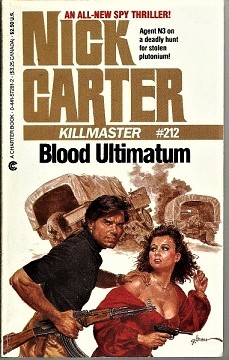
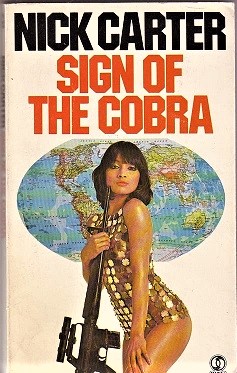
Virtually forgotten today, Nick Carter predates Dashiell Hammett’s Sam Spade, Raymond Chandler’s Philip Marlowe, and was originally inspired by the real-life exploits of private investigator Allan Pinkerton.
“The Case of the Sick Statue” was tightly written and kept the listener guessing as to the nature of the sick statues as well as who committed several murders. No wonder that at the closing credits it was announced that none other than SFWA Grand Master Alfred Bester (1913-1987) had penned this episode, as he had numerous others for this and other radio shows. The story opens with Nick receiving a plea for help from the housemaid of a rich art collector. Maisie, the maid, is alarmed when she notices that some of the sculptures in the mansion appear to be gradually covered in some kind of creeping plague. All of the other servants have fled. Skeptical but interested, Nick agrees to see Maisie, but on arriving at the art collector’s home he and Patsy find Maisie murdered. The plot thickens as someone else in the large house is found murdered, and Nick and the police have a devil of a time trying to put the seemingly disparate pieces of these murders together, not to mention the cause of the apparently decaying (for want of a more precise word) statues. This is a crackerjack murder mystery that will keep you guessing throughout, and I recommend it to you.
Play Time: 29:36
{This episode of Nick Carter aired on a Sunday afternoon in mid-August of 1945, a few weeks before another summer vacation would come to a close and back to school it would be for the neighborhood gang. Early the next morning they met at the nearby newsstand to find more examples of the Good Guys vs. the Bad Guys, and it wasn’t long before they found just what they were looking for. “Detective Story Magazine was the first pulp magazine devoted to detective fiction, and was actually a continuation of the dime novel series Nick Carter Stories with its first issue continuing a serial begun in that magazine.” The magazine had a phenomenal run of 34 years (1913-53) and for half of that time held to a weekly schedule. It was a monthly in 1945. Super-Detective (1940-50) relaunched in 1940 after folding in 1935 after only 15 issues. This time around it was more character focused, with each issue showcasing an entire novel around one Jim Anthony, “scientist, businessman, adventurer.” Discontinuing the Jim Anthony stories, the magazine continued with an uneven schedule until its demise in 1950, its yearly schedule roller-coasting from 2 to 9 issues a year. It produced 9 issues in 1945. Ten Detective Aces (1928-49) began with stories featuring gangsters and organized crime, but soon switched to detective tales when it became apparent that the audience was tiring of such stories. The new formula proved successful, maintaining a monthly schedule for most of its run until 1943 when the problems brought about by World War II finally hit the pulp magazine industry, forcing the magazine to down-schedule to bi-monthly production in 1945.}
[Left: Detective Story Magazine, 8/45 – Center: Super-Detective, 7/45 – Right: Ten Detective Aces, 9/45]
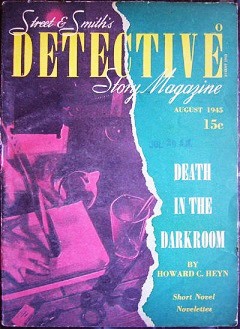
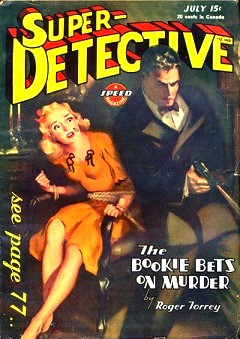
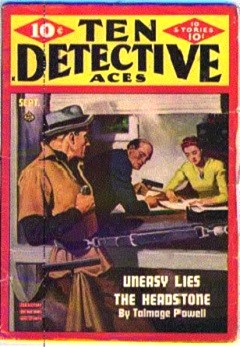
To view the entire list of weekly Old Time Radio episodes at Tangent Online, click here.